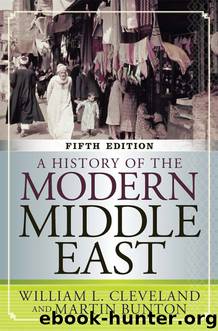A History of the Modern Middle East by William L Cleveland

Author:William L Cleveland [Cleveland, William L.; Bunton, Martin]
Language: eng
Format: epub
ISBN: 9780813348346
Publisher: Westview Press
THE ADOPTION OF ARAB SOCIALISM
As noted previously, the Free Officers seized power without a predetermined ideology. From 1952 to 1961, the regime acquired legitimacy through its foreign policy ventures and Nasser’s immense popularity. But the regime did not establish a set of guiding principles that might have served to inspire popular commitment. Following the breakup of the UAR in 1961, Nasser and his associates reassessed their domestic policies and concluded that Egypt’s successful economic development required the adoption of selected elements of socialism. They called their version of the ideology Arab socialism in an attempt to show that it had indigenous roots. Arab socialism became the rallying cry of the regime, the doctrine intended to attract a new generation of Egyptians to the achievement of revolutionary goals.
The government adopted socialism for pragmatic reasons, not out of any longstanding ideological commitment. Indeed, during the regime’s early years in power, it offered incentives to foreign and local private investors. However, Nasser’s Egypt was not an attractive haven for surplus investment capital, and the regime had difficulty raising funds. Therefore, in order to generate the funds needed for its development schemes, the government decided to take over most of Egypt’s enterprises and to become responsible for all capital formation. In this sense, the economic policy of the regime was more a form of state capitalism than Marxist socialism; it was based on the need to raise money, not on the dynamic of class conflict.
The most concentrated wave of socialist decrees occurred from 1961 to 1964. In these years the remaining foreign-owned companies as well as all domestic enterprises, from banks to insurance companies, from import agencies to hotels, were nationalized. Even the media were brought under state control, and Egypt’s once lively press became a possession of the central government and was subject to rigorous censorship. Planning agencies were set up to manage the economy, and in 1960 Egypt announced its first five-year plan. The plan placed heavy emphasis on industrial development. During the 1960s, industrial output increased substantially, especially in the production of textiles and food and beverages. Nevertheless, the regime’s fascination with large-scale showcase projects, most notably the iron and steel plant at Helwan, resulted in huge expenditures for modest returns. An additional barrier to industrial expansion lay in the very nature of state-run industries: They were subjected to rigid central-planning mechanisms, they were overstaffed at the managerial level, and they had little incentive for quality control because they had no competition. The regime also spent large sums on various land reclamation schemes, none of which proved very successful. However, the completion of the Aswan Dam in 1970 allowed 650,000 feddans to be reclaimed as agricultural land. The undeniable benefits of the Aswan Dam, however, have been mitigated by a host of ecological side effects.
Any improvement in the overall Egyptian economy demanded that the government take measures to limit the country’s soaring birthrate. Although the 1962 charter (discussed in the following section) made reference to family planning, the government did not pursue the matter in a systematic fashion.
Download
This site does not store any files on its server. We only index and link to content provided by other sites. Please contact the content providers to delete copyright contents if any and email us, we'll remove relevant links or contents immediately.
| Africa | Americas |
| Arctic & Antarctica | Asia |
| Australia & Oceania | Europe |
| Middle East | Russia |
| United States | World |
| Ancient Civilizations | Military |
| Historical Study & Educational Resources |
Empire of the Sikhs by Patwant Singh(22767)
The Wind in My Hair by Masih Alinejad(4843)
The Templars by Dan Jones(4558)
Rise and Kill First by Ronen Bergman(4545)
The Rape of Nanking by Iris Chang(4023)
12 Strong by Doug Stanton(3419)
Blood and Sand by Alex Von Tunzelmann(3056)
The History of Jihad: From Muhammad to ISIS by Spencer Robert(2506)
Babylon's Ark by Lawrence Anthony(2431)
The Turkish Psychedelic Explosion by Daniel Spicer(2245)
Gideon's Spies: The Secret History of the Mossad by Gordon Thomas(2235)
No Room for Small Dreams by Shimon Peres(2235)
Inside the Middle East by Avi Melamed(2230)
Arabs by Eugene Rogan(2193)
The First Muslim The Story of Muhammad by Lesley Hazleton(2154)
Bus on Jaffa Road by Mike Kelly(2035)
Come, Tell Me How You Live by Mallowan Agatha Christie(2026)
Kabul 1841-42: Battle Story by Edmund Yorke(1921)
1453 by Roger Crowley(1880)
